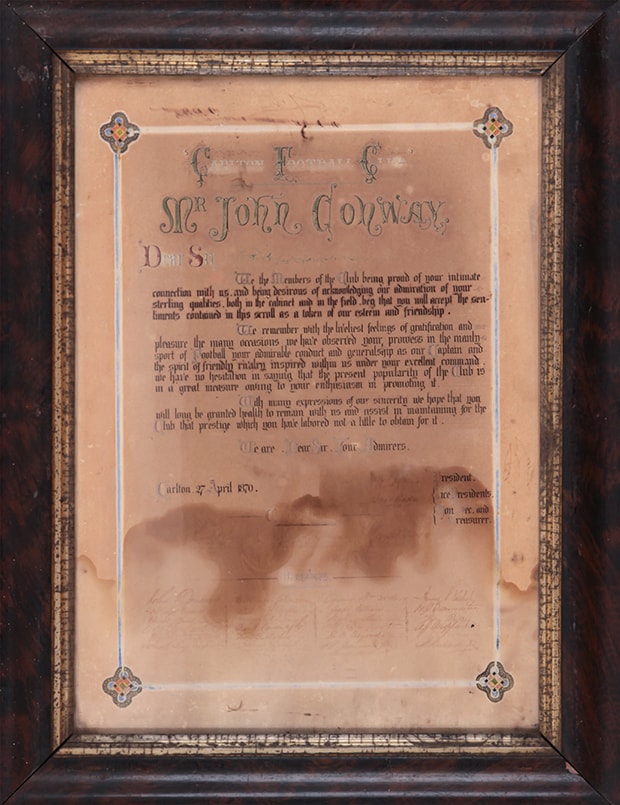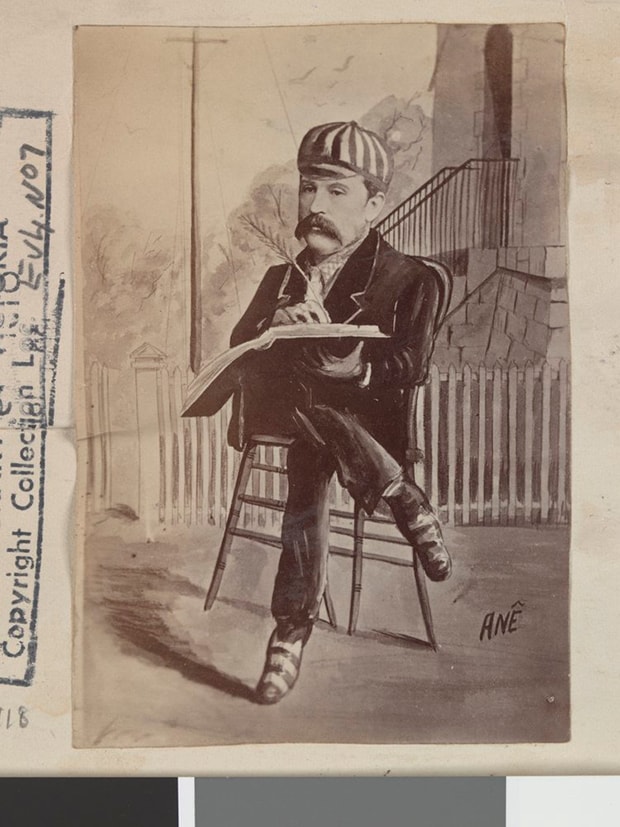A Carlton Football Club certificate presented to the former Captain John (“Jack”) Conway way back in 1870 has been found in the vault of the Sydney Cricket Ground Museum some 145 years after the event.
The darkened, water-damaged certificate, carrying the precious signatures of yesteryear’s champions Orlando “Lanty” O’Brien, Jack Donovan, Dr. Jim Duncan and John “Tiger” Gardiner, was located through the diligence of The Blueseum website’s researcher Pete McLean, who found reference to the certificate after scouring a recently digitised version of The Leader newspaper of March 30, 1895.
Located on page 18 of the relevant edition, beneath the headline “Cricket Gossip”, the correspondent “Mid-On” wrote;
“After one of my recent visits to Sydney I made reference to an illuminated address presented to J. Conway about 25 years ago by the Carlton football club (of which I need hardly say he was captain in the days when H.C.A. Harrison led Melbourne on the hard gravel in the Richmond paddocks) occupying a place in the pavilion of the Sydney Cricket Ground.”
On making this discovery, McLean contacted the club suggesting that contact in turn be made with the SCG Museum to determine whether the certificate was still in its keep.
Accordingly, this reporter called Sydney Cricket and Sports Ground Trust Museum Curator Leah Domanski, who duly found a listing for the certificate on the museum’s database.
Equally interested in the item’s provenance, Domanski arranged for the certificate to be taken from the vault and digitally scanned, with the scanned image on-forwarded to the club for its records.
Bound by a hand-drawn blue and white border, the framed Carlton Football Club pen and ink certificate, dated April 27, 1870, carries the signatures of the then President George Coppin, the Vice-Presidents (names undecipherable) and the Honorary Secretary and Treasurer Tom Power, together with the aforementioned footballers and club members.
Acknowledging Mr. John Conway, the certificate reads as follows;
Dear Sir,
We the Members of the Club being proud of your intimate connection with us, and being desirous of acknowledging our admiration of your sterling qualities, both in the cabinet and on the field, beg that you will accept the sentiments contained in this scroll as a token of our esteem and friendship.
We remember with the liveliest feelings of gratification and pleasure the many occasions we have observed your prowess in the manly sport of football, your admirable conduct and generalship as our Captain and the spirit of friendly rivalry inspired within us under your excellent command, we have no hesitation in saying that the present popularity of the Club is a great measure owing to your enthusiasm in promoting it.
With many expressions of our sincerity we hope that you will long be granted health to remain with us and assist in maintaining for the Club that prestige which your labored not a little to obtain for it.
We are, Dear Sir, your Admirers.

The certificate (image courtesy of the SCG Museum).
Jack Conway was born in Fyansford, a township on the western edge of Geelong, on February 3, 1842, and schooled at Scotch College and later Melbourne Grammar. A foundation student at Melbourne, Conway was tutored by the future Prime Minister Alfred Deakin.
It was there that Conway rose to prominence as a cricketer. He was only 19 when named to represent the Victorian team against the touring English - who had arrived aboard the Great Britain in December 1861 – and in the first match involving the two teams, Conway, known as “The Colt”, secured four wickets, one of them the prized scalp of the English captain HH Stephenson.
In 1862, on the Melbourne ground, Conway completed his debut in the intercolonial match against New South Wales, taking three wickets for 17 in the first innings and 6 for 69 in the second.
A club cricketer for St Kilda, Melbourne, East Melbourne and later South Melbourne of which he captained for several seasons, Conway led South to the 1874/75 Challenge Cup match against East Melbourne which, according to one reporter, “took about seven Saturdays to finish”.
That the Conway certificate should emerge at a time when the touring Australia Test cricket team is locked in earnest battle with England in the Old Dart is incredible, considering that it was Conway who concoted the idea of taking an Australian team there.
Conway’s successor at The Australasian, the writer “Felix”, noted that when Charles Bannerman’s magnificent 165 sunk Lillywhite’s English touring team on the Melbourne ground in 1876/7, Conway conceived the idea of banding together an England-bound Australian team.
“ . . . being a man quick to act, he set to work without delay; and, with undaunted spirit, overcame all obstacles and had his team ready in November 1877 to tour Australia and New Zealand under the captainship of his old friend, the New South Welshman Dave Gregory,” Felix wrote.
“How well that first Australian team did in England is well-known, and to Jack Conway, and to him alone, the credit is due for initiating and establishing these visits to the old country and America – visits which have proved by far the best advertisement Australia ever had.”
Conway joined Carlton two years after its founding, and represented his club in a six-year period (quota of games unknown) from 1866-1871, the final three as captain. Clearly he was a formidable presence - variously considered by scribes of the day as “hard as nails”, all “sinew and strength” and “the man who made Carlton what it is”.
Felix wrote that Conway “was as strong as a house”.
“Forty-three in the chest, with thighs, calves, biceps and forearm to match, he was a formidable opponent to shoulder in a football field, and in the old days when he captained Carlton in their great matches with Melbourne, it was something to be remembered when that grand and fearless footballer, the great old skipper of the reds. H.C.A. Harrison – lithe, sinewy, well-conditioned, strong, and hard as nails – sprang with panther-like bound against the Herculean captain of the blues, solid as a rock, waiting for the charge,” Felix noted.
“The impact was so tremendous that the very ground seemed to tremble with the shock.”
Not surprisingly, injury brought premature end to Conway’s on-field career at Carlton. By then he was a favourite of the masses, amongst them “The Community Poet”, who paid the following glorious tribute;
There’s gladness in remembrance
- John, of rivals you had few,
When o’er the notorious rugged ground
you led the famed Dark Blue
You’ve joined in many a gallant charge
- after the flying leather,
And I often think of the good old days
when we were boys together.'

Jack Conway scoring on October 25, 1878.
By the 1880s, Conway and his wife Elizabeth had relocated to Sydney. There, he embarked on a career as a sportswriter for the Sydney Morning Herald and Sydney Mail newspapers, and for a time served as proprietor of the Sporting Life. Later, on his return to Melbourne, Conway established a sporting and dramatic paper in conjunction with Garnet Walch.
An ailing Conway was 66 when he died of what was reported as “severe heart affection” at Frankston at three o’clock on the morning of Sunday, August 22, 1909. His remains were interred in the family grave in the Old Cemetery in West Melbourne, where his father and brother were buried.
“To the last he loved to talk of old South Yarra and Carlton days, when he played with George O’Mullane, Murray Smith, Morrell, Dutton and Harry Nudd, Colonel Robertson, the Rev. George Tait, George Robertson, J. Byrne, Theo, Marshall, C. Forrester, F.H. Bruford, Jack Bennie, Frank Hillsden, Harry Guy, Tom Gorman, Tom Wills, “Lanty” O’Brien and other noted players,” Felix wrote.
“His name should live for ever in the annals of Australian cricket, by reason of the splendid work he did in organising the pioneer Australian team for England, and hope that our M.C.C. will take steps to have some permanent memorial on the pavilion walls to keep green the name and work of the dead and gone old warrior.”
How the Conway certificate found its way to the SCG may never be known, although the man’s links with the summer sporting pastime are clearly undeniable and for a period he was domiciled in the Harbor City.
The SCG Museum, in good faith, has kindly availed the digitised version of the certificate for publication, with the original to be restored at a later date.
“In addition to a planning conservation work on this important item, which links the formative years of the SCG with Australian football - something we’ve long known as an important part of our history, museum staff will delve into our archives in an effort to establish how the address came to be hung on the walls of our pavilion,” Museum Curator Leah Domanski said.
“Any new evidence will be included in the museum’s object record and shared with the Carlton Football Club so future generations will be illuminated to the history of this marvellous address, brought to light once again with the assistance of the club.”
Whether the precious item ever finds its way back to old Carlton town is anyone’s guess, although the correspondent Mid-On was in no doubt when he put ink to parchment way back in 1895.
As Mid-On wrote of the rediscovered Conway certificate: “Like other visiting Victorians I could not help thinking that this interesting relic of the past, bearing the autographs of such old-time celebrities as “Lanty” O’Brien, Jack Donovan . . . Jack Gardiner and a host of others who were wont to respond to the call of “wire in Carlton!” in the sixties and seventies, had no right to have found an abiding place so far from home”.




